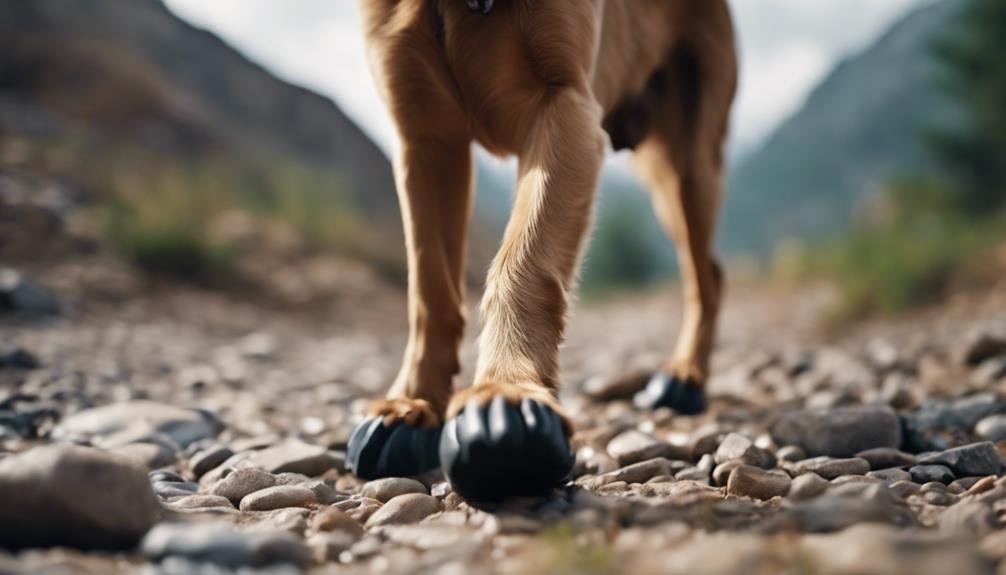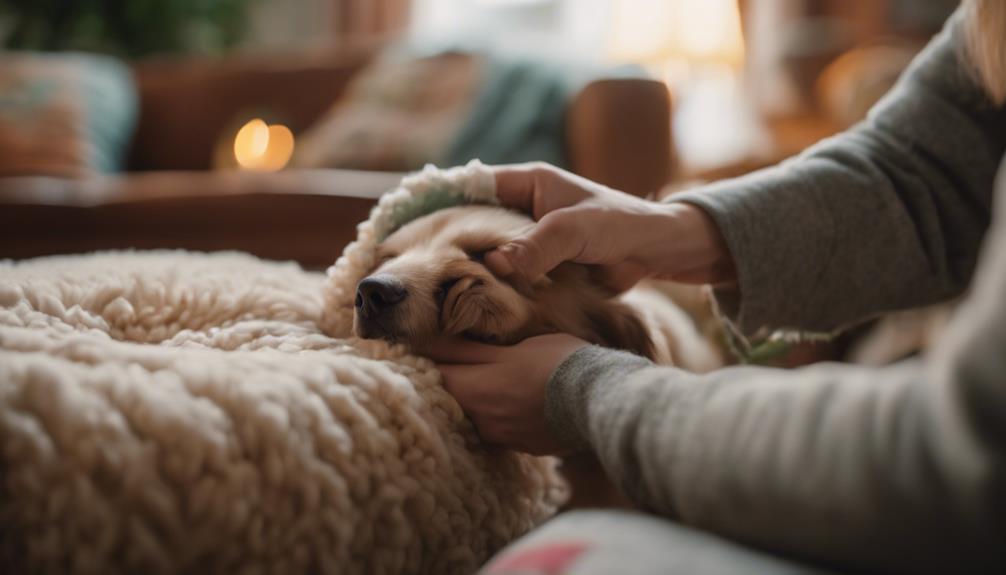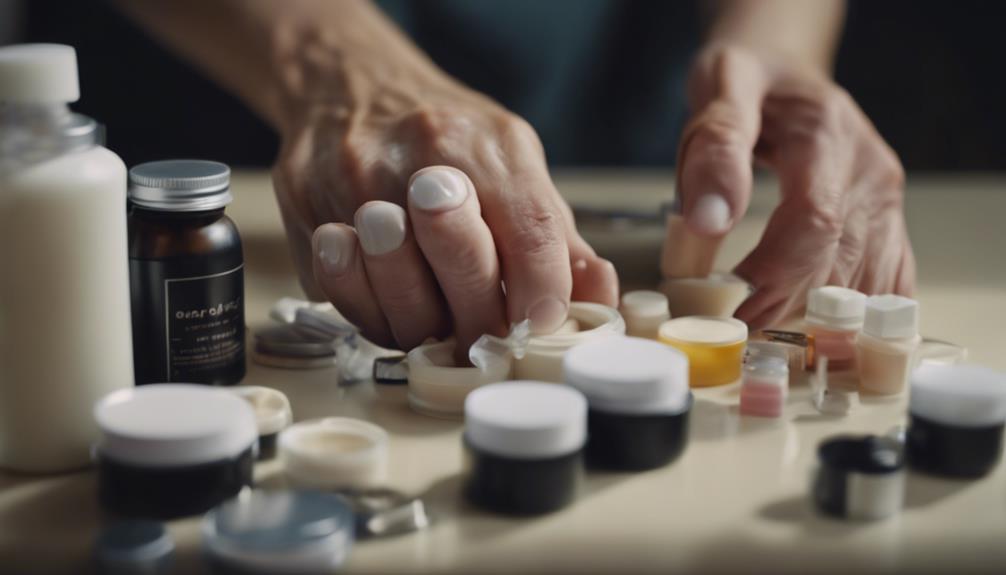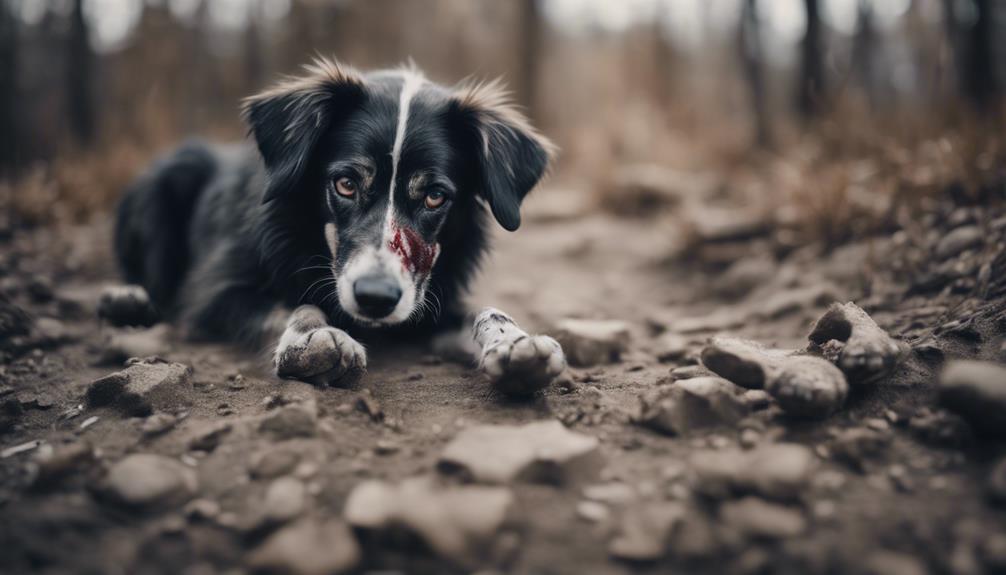As responsible pet owners, safeguarding our canine companions from the discomfort of cracked paw pads and dry skin is a crucial aspect of their overall well-being. By understanding the environmental factors and harmful substances that can contribute to these issues, we can devise effective prevention strategies to protect our pups.
Implementing proactive measures such as using protective balms, providing soft surfaces, and considering appropriate footwear can significantly reduce the risk of paw injuries and skin ailments in our beloved dogs.
Stay tuned to discover comprehensive guidance on maintaining optimal pet health and comfort by preventing cracked dog paws and shielding your pup's skin from dryness.
Key Takeaways
- Protect dog paws from weather extremes with booties or soft surfaces.
- Treat cracked paws with coconut oil, Bag Balm, or wax-based products.
- Consult a vet for suitable paw care products and timely treatment.
- Watch for signs of pain, infection, or underlying health issues; seek veterinary care promptly.
Weather Impact on Paw Health
In understanding the impact of weather on paw health, it is crucial to recognize how environmental conditions such as hot summer sidewalks and cold winter surfaces can significantly affect a dog's paw pads. During the summer, hot pavements can reach temperatures that are uncomfortable and potentially harmful to dogs' sensitive paw pads, leading to burns and blisters.
On the other hand, in winter, cold sidewalks and icy surfaces can cause dryness and cracking of the paw pads, making them susceptible to injury and discomfort. It is essential for pet owners to be mindful of these weather-related risks and take preventive measures, such as limiting exposure to extreme conditions, using protective booties, or opting for softer walking surfaces to ensure their dog's paw health and well-being.
Harmful Effects of Ice Melt Chemicals
Exposure to ice melt chemicals can pose significant risks to the health and safety of dogs' paw pads. These chemicals are commonly used to de-ice sidewalks and roads during winter, but they can be harmful to your furry friend. Here are some harmful effects of ice melt chemicals:
- Chemical Burns: Ice melt chemicals can cause chemical burns on your dog's paw pads.
- Irritation: These chemicals can irritate the skin on your dog's paws, leading to discomfort and potential infections.
- Ingestion Risks: Dogs may accidentally ingest these chemicals while licking their paws, which can result in poisoning.
- Dryness and Cracking: Prolonged exposure to ice melt chemicals can dry out the paw pads, making them more prone to cracking and injuries.
Preventing Paw Injuries Outdoors

To safeguard your dog's paw health during outdoor activities, proactive measures can be implemented to prevent potential injuries. When engaging in outdoor adventures with your furry companion, it is crucial to inspect the walking surface for any hazards like sharp objects, rough terrain, or hot surfaces.
Utilizing protective gear such as dog booties can offer an additional layer of defense against abrasive surfaces and extreme temperatures. Additionally, maintaining a suitable exercise routine to gradually build up paw strength and resilience can reduce the risk of injuries during physical activities.
Soothing Cracked Paws With Oils
Utilizing natural oils can be an effective method for soothing cracked paws in dogs, providing nourishment and promoting healing for their sensitive paw pads. When considering oils for your pup's paw care, here are some options to explore:
- Coconut Oil: Known for its moisturizing properties, coconut oil can help hydrate and repair dry paw pads.
- Olive Oil: Rich in antioxidants and vitamins, olive oil can aid in soothing and softening cracked paw skin.
- Almond Oil: Gentle and hypoallergenic, almond oil can be beneficial for sensitive paw pads, promoting healing and protection.
- Jojoba Oil: With its natural anti-inflammatory properties, jojoba oil can help reduce irritation and promote overall paw health.
Bag Balm for Topical Treatment

When addressing the topical treatment of cracked paws in dogs, one effective option to consider is utilizing Bag Balm for its healing properties and protective benefits.
Bag Balm is a time-tested ointment containing lanolin and moisturizing emollients that can help soothe and repair dry, cracked paw pads.
The balm creates a barrier that shields the paw pads from further damage caused by environmental factors like hot pavement or icy surfaces.
By applying Bag Balm regularly to your dog's paws, you can promote healing and prevent discomfort associated with cracked skin.
Remember to consult with your veterinarian before starting any new treatment regimen to ensure it is suitable for your pet's specific needs.
Wax-Based Products for Paw Protection
One effective method for safeguarding your dog's paws from environmental elements is through the application of wax-based protective products. These products create a barrier that shields the paw pads from harsh conditions and helps retain moisture, preventing dryness and cracking.
When selecting a wax-based product for your pup, consider the following factors:
- Ingredients: Look for natural ingredients like beeswax or shea butter for gentle protection.
- Application: Opt for easy-to-apply products that are not too sticky or greasy for your dog's comfort.
- Longevity: Choose a product with long-lasting effects to provide extended paw protection.
- Effectiveness: Prioritize products with proven effectiveness in shielding against extreme temperatures and rough surfaces.
Consulting Vet for Paw Products

To ensure the optimal care and protection of your dog's paw pads, consulting a veterinarian for guidance on suitable paw products is crucial for maintaining their overall paw health. Veterinarians can recommend specific paw balms, creams, or waxes tailored to your dog's individual needs, taking into account factors such as breed, activity level, and any existing paw conditions.
These professionals can also advise on the application frequency and proper usage of these products to maximize their effectiveness in preventing dryness and cracking. By seeking expert advice, pet owners can ensure that they are using safe and effective paw care products that promote healthy paw pads and contribute to the overall well-being of their furry companions.
Applying Protection Before Outdoors
Before venturing outdoors with your dog, it is essential to apply protective measures to safeguard their paw pads from potential harm. To ensure your furry friend's paws stay healthy and protected, consider the following steps:
- Apply a paw balm: Coat your dog's paw pads with a protective balm to create a barrier against harsh weather conditions.
- Use dog booties: Consider using booties to shield your dog's paws from hot surfaces, ice, or chemicals on the ground.
- Moisturize with wax-based products: Apply wax-based petroleum products to keep paw pads moisturized and shielded from extreme temperatures.
- Check paw pad condition: Regularly inspect your dog's paw pads for any signs of dryness or cracking before heading outdoors.
Consequences of Untreated Cracked Paws

Neglecting to address and treat cracked paws in dogs can lead to significant consequences that may result in discomfort, pain, and potential infections for the animal. If left untreated, cracked paws can worsen, causing pain and increasing the risk of infections. Here is a table outlining the consequences of untreated cracked paws:
| Consequence | Description |
|---|---|
| Discomfort | Walking and running can become painful. |
| Pain | Dogs may limp or avoid putting weight on the affected paw. |
| Infections | Cracks can allow bacteria to enter, leading to infections. |
| Difficulty Healing | Untreated cracks may take longer to heal. |
| Secondary Issues | Cracked paws can lead to more serious health problems if left untreated. |
Signs to Visit the Vet
When observing specific signs indicating potential issues with your dog's cracked paws, seeking veterinary care promptly is essential for proper evaluation and treatment. Here are some signs that indicate it's time to visit the vet:
- Lameness: If your dog is limping or favoring a paw, it could be a sign of pain or injury.
- Constant Licking: Excessive licking of the paws may indicate irritation, infection, or discomfort.
- Visible Swelling or Redness: Any noticeable swelling, redness, or inflammation on the paw pads should be examined by a professional.
- Foul Odor or Discharge: Unusual smells or discharge from the paws could signal an infection that requires veterinary attention.
Prompt veterinary care can help address these issues before they worsen, ensuring your dog's paw health and overall well-being.
Indications of Health Issues

Noticing unusual symptoms in your dog's paw health can serve as crucial indicators of underlying health issues that may require veterinary attention. Persistent redness, swelling, or tenderness in the paw pads could suggest an infection or allergic reaction.
Excessive dryness and cracking may point towards nutritional deficiencies or skin conditions. Limping or reluctance to put weight on a paw could indicate a musculoskeletal problem or injury.
Additionally, if you observe your dog constantly licking or chewing at their paws, it might be a sign of pain, irritation, or even anxiety. It is essential to monitor your dog's paw health regularly and seek veterinary care promptly if you notice any concerning signs to ensure early diagnosis and appropriate treatment.
Related Articles on Paw Care
In the realm of pet care literature, several informative articles focusing on paw care have gained prominence due to their valuable insights and practical tips for maintaining your dog's paw health.
To further your knowledge on this topic, check out the following related articles:
- Protecting dogs' paws from hot surfaces: Learn how to safeguard your pup's paws from burns and injuries during the summer months.
- Dog paw balms for protection and care: Discover the benefits of using paw balms to keep your dog's paw pads healthy and moisturized.
- Understanding dry dog noses: Explore the reasons behind your dog's dry nose and how to provide relief.
- Best dog paw washers for cleanliness: Find out about effective paw washing tools to maintain your dog's paw hygiene.
Conclusion
In conclusion, safeguarding your canine companion's paw health is essential for their overall well-being. By understanding the factors that can lead to cracked paws and dry skin, implementing preventative measures, and seeking veterinary care when necessary, pet owners can ensure their pups stay comfortable and healthy.
Taking proactive steps to protect your dog's paws will help prevent injuries and promote optimal skin health, ultimately enhancing their quality of life.




